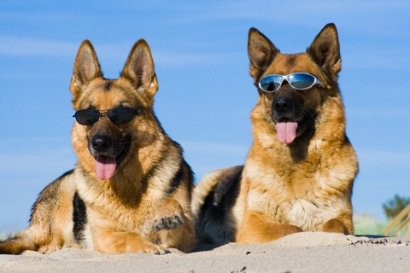Skin Cancer in Dogs
Sun Protection is a fact of life™
Unfortunately, skin cancer in dogs is something which very few dog owners even think about, and it's hardly surprising really when you consider that so many people aren't even aware of the fact that dogs can get skin cancer in the first place.
However, statistics suggest that approximately one in every 200 dogs end up with some form of skin cancer every year.
Fortunately, there are steps you can take in order to determine whether or not your dog has skin cancer, and of course just as with humans, the risk of developing the disease can be kept at a minimum.

Generally speaking, skin cancer in dogs is usually caused by DNA becoming damaged when a dog is constantly exposed to the harmful ultraviolet rays coming from the sun.
In particular, dogs with a very light pigment or bare patches of skin tend to be the most vulnerable, although certain breeds such as bull terriers for example are also considered to be high risk.
Of course, before you attempt to examine your dog for skin cancer, you first need to familiarize yourself with your dog's skin.
This can be done by examining it in order to see if there are any changes in the overall appearance. If you feel any unusual lumps which were not there before then, you should consider taking your dog to a vet.
Unexplained fatigue and/or lack of appetite could also indicate that your dog has skin cancer and here again, a visit to the vet is recommended.
4 Ways to Avoid Skin Cancer in Dogs
• Choose a suitable breed - Ideally, if you live in a particularly hot climate then you should try and have a dog which has a dark pigmented skin. Likewise, you should try to choose a breed which has relatively long hair.
• Use Sunscreen When Necessary - If your dog has a light pigmented skin or bare patches of skin then you should always apply a suitable sunscreen, particularly if your dog spends a lot of time outdoors in the sun. You should also consider applying sunscreen to the nose, underside, and the armpits.
• Canine clothing - Items of dog clothing can certainly help in terms of offering some degree of UV protection, but of course, it's often impossible to keep clothing on your dog for more than a few hours, bearing in mind that they will either simply fall off or else your dog will decide they make great toys.
• Keep exposure to a minimum - It is always best to avoid walking your dog during the hottest time of the day, both for your sake and for the sake of your dog. Likewise, if your home stands empty during the day because of everyone being at work, then you'll need to ensure that your dog has a place where it can lay down out of the sun.
The most important thing of all is that you realize that skin cancer in dogs is far more widespread than what many believe, but providing you take some precautionary measures, you can do a lot in terms of preventing the disease from developing in the first place.








New! Comments
Have your say about what you just read! Leave me a comment in the box below.